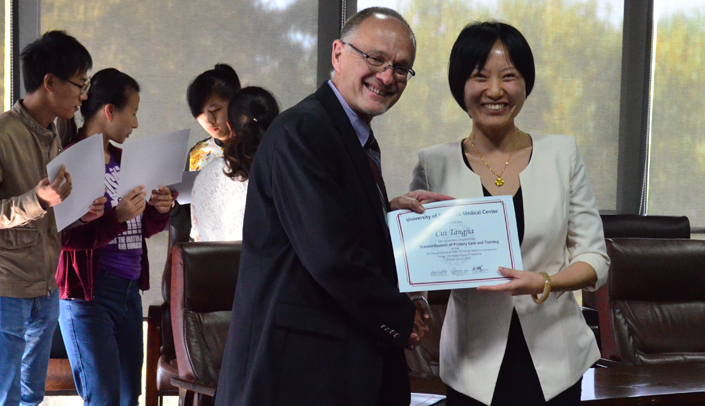While some of the challenges faced by China’s family medicine physicians are similar to what U.S. family medicine physicians face, others are strikingly different.
Like having only 300 family medicine physicians to care for 3 million people, and that’s in just one district of Shanghai.
Improving family medicine
In 2009 UNMC established two SINO-US joint training centers in Shanghai and Xi’an to help universities there understand and improve family medicine practice by developing curriculum to educate Chinese-adapted family medicine practitioners. The joint family medicine department between UNMC and Tongji University in Shanghai was established in 2013.
Since then annual symposiums have helped train thousands of practitioners in the last five years and more than 40 Chinese physicians have traveled to UNMC to participate in family medicine leadership courses since 2012.
“Training the leaders of tomorrow is perhaps the biggest impact we can make on family medicine practice in China,” Jeff Harrison, M.D., said.
Or the lack of respect that often leads to violence against the physician.
These and other issues were voiced by three community health center directors on the third day of the fifth annual SINO-US Family Medicine Symposium held at Tongji University Oct. 20-22.
A similar symposium was held in Xi’an at Jiao Tong University Oct. 23-24. Presenters at both symposiums included Mike Sitorius, M.D., Jeff Harrison, M.D., Kim Jarzynka, M.D., Jayme Nekuda, Ph.D., Marilyn Sitorius, M.D., Kent Zhao, M.D., Jialin Zheng, M.D., and UNMC College of Medicine Dean Brad Britigan, M.D.
The focus this year was on effective communication between doctors and patients in an effort to help physicians ward off some of the anger they face from patients.
“China has started to build the family medicine system in recent years, much like what the United States has been doing since the late 1970s,” said Jialin Zheng, M.D., associate vice chancellor for academic affairs and director of the Asia Pacific Rim Development Program.
“The shortage of high quality family medicine physicians is the most limiting factor in the Chinese health care system,” Dr. Zheng said.
In the U.S. a physician may only see 20 patients a day, but if you’re a family medicine physician in China, you’re more likely to see 150 patients a day.
Most of those patients want a quick fix, one community health center director said. Often they are looking for a prescription that may or may not be what they need, but it’s what they expect.
And if they don’t get what they want it can lead to frustration, anger and sometimes, violence, an issue addressed by Dr. Nekuda who gave a talk at both symposiums on how to deal with angry patients.
“It’s amazing to see how far they’ve come in the past five to six years since we first started teaching family medicine practice,” Dr. Harrison said. “We’ve gone from talking about what family medicine is to really getting into the skills used in day-to-day practice that contribute to better outcomes.”
